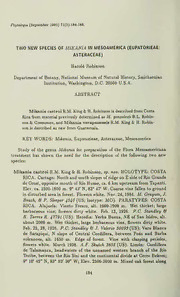Table Of ContentPkytologia (September 1991) 71(3):184-186.
TWO NEW SPECIES OF MIKANIA IN MESOAMERICA (EUPATORIEAE:
ASTERACEAE)
Harold Robinson
Department of Botany, National Museum of Natural History, Smithsonian
Institution, Washington, D.C. 20560 U.S.A.
ABSTRACT
MikaniacastroiR.M. King& H. Robinsonis describedfromCosta
Ricafrommaterialpreviously determined as M. gonzaleziiB.L. Robin-
son & Greenman,and Mikania verapazensisR.M. King & H. Robin-
son is described as new from Guatemala.
KEY WORDS: Mikania, Eupatorieae, Asteraceae, Mesoamerica
Study of the genus Mikania for preparation of the Flora Mesoamericana
treatment has shown the need for the description of the following two new
species:
Mikania castroi R.M. King & H. Robinson, sp. nov. HOLOTYPE: COSTA
RICA. Cartago: North and south slopes ofridgeon E sideofRio Grande
de Orosi, opposite mouth ofRio Humo, ca. 6 km upstreamfromTapantf.
Elev. ca. 1500-1800 m. 9° 43' N, 83° 47' W. Coarse vine fallen to ground
in disturbed areain forest. Flowers white. Nov. 24, 1984. M. Grayum, J.
Beach, & P. Sleeper 4540 (US; Isotype: MO). PARATYPES: COSTA
RICA. Alajuela: Viento Fresco, alt. 1600-1900 m. Wet thicket; large
herbaceous vine; flowers dirty white. Feb. 13, 1926. P.C. Standley &
R. Torres R. 47791 (US). Heredia: Yerba Buena, NE of San Isidro, alt.
about 2000 m. Wet thicket, large herbaceous vine, flowers dirty white.
Feb. 22, 28, 1926. P.C. Standley & J. Valerio 50093{US); Vara Blanca
de Sarapiqui, N slope of Central Cordillera, between Pods and Barba
volcanoes, alt. 1650 m. Edge of forest. Vine with clasping petioles,
flowers white. March 1938. A.F. Skutch 3655 (US). Limon: Cordillera
de Talamanca, headwaters of the unnamed western branch of the Rio
Teribe, between the Rio Sini and the continental divide at Cerro Bekom;
9° 10' 45" N, 83° 03' 30" W; Elev. 2500-2600 m. Mixed oak forest along
184
Robinson: New species ofMesoamerican Mikania 185
river with a clearing of kikuyu pasture. Vine, florets white. March 21 &:
27, 1984. G. Davidse, G. Herrera Ch. & R.H. Warner 25784 (MO,US).
Puntarenas: Monteverde, sendero Chomogo. Elev. 1500-1600 m. Liana
en bosque secundario; flores blancas. Sept. 7, 1985. W.A. Haber & E.
Bello C. 2<S37(MO,US). San Jose: along route 216, ca. 8 km generally
N of Nubes. Elev. ca. 4900 ft. Uncommon vines up to 3 meters above
ground, flowers grey-white. June 13, 1974. R.M. King 6781 (US).
m
Plantae volubiles ad 3 altae; caules subteretes glabri in nodis
lateraliter non vel minutelobulati. Folia opposita, petiolis plerum-
que 2-7 cm longis; laminae ovatae 4.5-15.0 cm longae 1.5-9.0 cm
latae base late rotundatae vel subcordatae margine integrae vel re-
motedenticulataeapiceangusteacuminataesupraetsubtusglabrae
feread basem valde ascendentitertrinervatae. Inflorescentiaein in-
mm
ternodis elongatae flexuosae, ramis corymbosis, pedunculis 2-7
mm
longis sparse minute puberulis. Capitula 8-9 alta; bracteae
mm mm
subinvolucri ellipticae 3-5 longae 1.5-2.0 latae; bracteae
mm mm
involucrioblongae 6-7 longae et 1.0-1.5 lataeapicebreviter
acutae extus glabrae vel sparse minute puberulae. Corollae albae
mm
extus plerumqueglabrae, tubis cylindraceis 2.5-3.0 longis, fau-
mm mm
cibus nullis, lobis anguste oblongis ca. 2 longis 0.3-0.4 latis
inferne intus breviter dense papillosis, nervis loborum marginatis;
basi stylorum glabri; appendices stylorum dense breviter papillosi.
mm mm
Achaenia ca. 3.5 longa glabra; setae pappi 4.5-5.0 longae
vix scabridae apice non vel vix latiores.
The species is named for Victor Castro of the Universidad de Costa Rica,
Escuela de Quimica, San Jose, Costa Rica. Specimens of the species have
not previously been distinguished from Mikania gonzalezii B.L. Robinson &
Greenman, which also occurs in Costa Rica. Mikania gonzalezii was origi-
nally described from Mexico as having acute leaves with five nerves from the
shallowly cordate blade bases. The latter species has been known from Costa
Rica since a determination many years ago by S.F. Blake of an Austin Smith
collection (P2167, US). It has been recently redescribed and illustrated, and
recognized from Panama and from additional Mexican collections by Holmes
(1990). Distinctions ofthe new species from M. gonzalezii include the separa-
tion ofthe corolla lobes to the top ofthe basal tube, theveinsofthe lobe being
close to the margin, the completely glabrous leaves and stem internodes, and
the more weakly scabrid pappus bristles with tips not or scarcely broadened.
Mikania verapazensis R.M. King & H. Robinson, sp. nov. HOLOTYPE:
GUATEMALA. Alta Verapaz: Mountains E of Tactic, on road to
Tamahii, alt. 1500-1650 m; dense wet forest. Woody vine. April 9,
1939. P.C. Standley 71313(F).
PHYTOLOGIA
186 volume 71(3):184-186 September 1991
Plantae volubiles ad 3 m? altae sparse ramosae; caules sub-
terete6 pilosi in nodis non lobulati. Folia opposita, petiolis plerum-
que 1-2 cmlongis; laminae ovatae circa vel ultra l,j longiores quam
latiores plerumque 6-9 cm longae 3-6 cmlatae baselate rotundatae
margine remote mucrono-denticulatae apice anguste acuminatae
subtus sparse pilosae e 1-2 mm supra basem trinervatae, nervis se-
cundariis ad £ ultimis attingentibus. Inflorescentiae in internodis
mm
elongatae flexuosae, ramis corymbosis, pedunculis 2-7 longis
mm
puberulis. Capitula c. 9 alta; bracteae subinvolucri ellipticae
mm
3-5 longae; bracteae involucri anguste oblongae acutae c. 7
mm mm
longae 1.5 latae extus glabrae; corollae albae?, tubis c.
3.5 mm longis, bmbis demum abrupte salverformibus, faucibus c.
mm mm
0.5 longis, lobis oblongo-ovatis c. 1.5 longis, nervis lo-
barum e marginis remotis; basi stylorum glabri; rami stylorum
mm
dense breviter papillosi. Achaenia c. 3.5 longa in costis dense
mm
spinoso-papillosa inter costas sparse puberula; setae pappi c. 5
longae apice vix latiores et vix scabridulae.
The single specimen is in poor condition, but distinctions are nevertheless
evident in the pilosity of the stem, the glabrous involucral bracts, the tips of
the pappus bristles, and the salverform limb ofthe corolla. The species differs
from both the closest relatives, Mikania gonzalezii and M. petrina Standley
& Steyermark, by the thinner and less roughened tips of the pappus bristles.
The new species is more pubescent than the nearly glabrous M. gonzalezii
but is less pubescent than M. petrina which has larger heads and pubescent
involucral bracts. The corollalimbs ofboth related species seem to be broadly
campanulate rather than salverform at maturity.
LITERATURE CITED
Holmes, W.C. 1990. The genus Mikania (Compositae - Eupatorieae) in
Mexico. Sida, Bot. Misc. 5:1-45.

